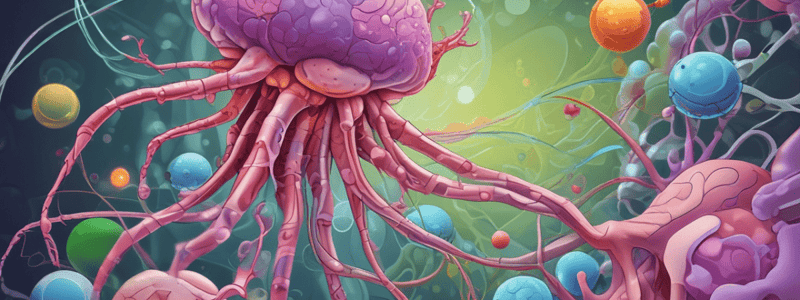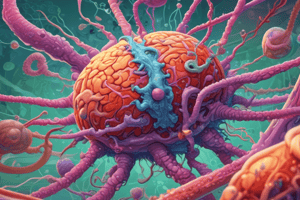Podcast
Questions and Answers
Which of the following is a type of carcinogen?
Which of the following is a type of carcinogen?
- Polycyclic aromatic compounds (correct)
- Chronic injury
- Hormonal stimulation
- Percival Pott
What is the definition of carcinogenesis?
What is the definition of carcinogenesis?
- The process of treating cancer
- The process of diagnosing cancer
- The process of initiation and promotion of cancer (correct)
- The process of preventing cancer
Benign tumours can never undergo malignant change.
Benign tumours can never undergo malignant change.
False (B)
Carcinogens can be viruses.
Carcinogens can be viruses.
What is an example of a gross defect mutation?
What is an example of a gross defect mutation?
What is the name of the fungus that produces aflatoxin, a carcinogen, in starchy foods?
What is the name of the fungus that produces aflatoxin, a carcinogen, in starchy foods?
The process of carcinogenesis involves changes in the ______________ of cells.
The process of carcinogenesis involves changes in the ______________ of cells.
The higher incidence of hepatocarcinoma in SE Asia compared to Australia is an example of an ______________ factor.
The higher incidence of hepatocarcinoma in SE Asia compared to Australia is an example of an ______________ factor.
What are the principle targets of genetic damage in carcinogenesis?
What are the principle targets of genetic damage in carcinogenesis?
Which of the following is an example of a physical agent that can cause cancer?
Which of the following is an example of a physical agent that can cause cancer?
Match the following types of mutations with their descriptions:
Match the following types of mutations with their descriptions:
Cancer is more common with decreasing age.
Cancer is more common with decreasing age.
Carcinogens only include chemicals and radiation.
Carcinogens only include chemicals and radiation.
Match the following extrinsic factors with their corresponding examples:
Match the following extrinsic factors with their corresponding examples:
What is the name of the carcinogen that was previously used in food products and is also known as 'Butter Yellow'?
What is the name of the carcinogen that was previously used in food products and is also known as 'Butter Yellow'?
What do growth promoting proto-oncogenes normally code for?
What do growth promoting proto-oncogenes normally code for?
What is the primary effect of thyroid-stimulating antibodies (TSI) in Graves' disease?
What is the primary effect of thyroid-stimulating antibodies (TSI) in Graves' disease?
Myasthenia gravis is an example of Type III immune complex mediated hypersensitivity.
Myasthenia gravis is an example of Type III immune complex mediated hypersensitivity.
What is the primary site of involvement in Myasthenia gravis?
What is the primary site of involvement in Myasthenia gravis?
In Graves' disease, excessive secretion of thyroid hormones leads to ______________ and decreased weight.
In Graves' disease, excessive secretion of thyroid hormones leads to ______________ and decreased weight.
What is the outcome of immune complexes (Ag-Ab) formation in Type III immune complex mediated hypersensitivity?
What is the outcome of immune complexes (Ag-Ab) formation in Type III immune complex mediated hypersensitivity?
Match the following diseases with their respective mechanisms:
Match the following diseases with their respective mechanisms:
Type II antibody-mediated hypersensitivity is characterized by the formation of immune complexes.
Type II antibody-mediated hypersensitivity is characterized by the formation of immune complexes.
What is the primary effect of thyroid-stimulating antibodies (TSI) on thyroid follicular epithelium?
What is the primary effect of thyroid-stimulating antibodies (TSI) on thyroid follicular epithelium?
What is the result of microthrombus formation and complement injury in Type III immune complex mediated hypersensitivity?
What is the result of microthrombus formation and complement injury in Type III immune complex mediated hypersensitivity?
Antibodies are involved in Type IV T cell mediated hypersensitivity.
Antibodies are involved in Type IV T cell mediated hypersensitivity.
What is the reaction that occurs in the skin in Type III immune complex mediated hypersensitivity?
What is the reaction that occurs in the skin in Type III immune complex mediated hypersensitivity?
In Type III immune complex mediated hypersensitivity, immune complexes form in response to _______________________
In Type III immune complex mediated hypersensitivity, immune complexes form in response to _______________________
What is the result of immune complex formation in glomerulonephritis?
What is the result of immune complex formation in glomerulonephritis?
Match the following type of hypersensitivity with its characteristic:
Match the following type of hypersensitivity with its characteristic:
Renal failure may occur in glomerulonephritis.
Renal failure may occur in glomerulonephritis.
What is the result of sensitized T-cells, killer cells, activated macrophages, and secretion of cytokines in Type IV T cell mediated hypersensitivity?
What is the result of sensitized T-cells, killer cells, activated macrophages, and secretion of cytokines in Type IV T cell mediated hypersensitivity?
What is the normal function of tumour suppressor genes?
What is the normal function of tumour suppressor genes?
All tumours have the same genetic makeup.
All tumours have the same genetic makeup.
What is the result of genetic alterations in key genes regulating growth?
What is the result of genetic alterations in key genes regulating growth?
Trisomy 21, as seen in Down's Syndrome, predisposes to ___________________.
Trisomy 21, as seen in Down's Syndrome, predisposes to ___________________.
What is an example of a racial and geographic factor in carcinogenesis?
What is an example of a racial and geographic factor in carcinogenesis?
What is the Philadelphia chromosome associated with?
What is the Philadelphia chromosome associated with?
Match the following genetic factors with their associated cancers:
Match the following genetic factors with their associated cancers:
Carcinogens are the sole cause of cancer.
Carcinogens are the sole cause of cancer.
Flashcards are hidden until you start studying
Study Notes
Carcinogenesis
- Carcinogenesis is the process of initiation and promotion of cancer
- A carcinogen is any agent or substance that initiates cancer, e.g. chemicals, radiation, viruses
- The process involves changes in the genome of cells, including mutations, over-expression of genes, or loss of activity of gene products
- Mutations may be gross defects (e.g. translocations or breaks in chromosome arms) or a defect involving a single base-pair of DNA (e.g. point mutations, substitutions, deletions)
Classes of Normal Regulatory Genes
- Four classes of normal regulatory genes are the principle targets of genetic damage:
- Growth promoting proto-oncogenes (normally code for proteins involved in the control of normal cell growth and differentiation)
- Growth-inhibiting tumour suppressor genes (normally discourage cell growth, or temporarily halt cell division to carry out DNA repair)
- Genes that regulate apoptosis (normally allow programmed cell death to occur, preventing further cell growth)
- Genes involved in DNA repair (normally allow repair of DNA following damage/mutations by stimuli)
Aetiology of Cancer
- Tumours have a multifactorial aetiology in which carcinogens play only one part
- Body factors (intrinsic factors) and environmental factors (extrinsic factors) both contribute to the causation of cancer
- Genetic makeup, racial background, climactic conditions, environmental agents, and diet may all contribute to cancer development
Intrinsic Factors
-
- Genetic factors:
- Leukaemia, e.g. Trisomy 21 in Down's Syndrome
- Chronic myeloid leukaemia, e.g. Philadelphia chromosome
- Polyposis coli, an autosomal dominant trait where hundreds of benign tumours form on the colonic mucosa
-
- Racial and geographic factors:
- Higher incidence of carcinoma of the breast in Australia compared to Japan
- Higher incidence of hepatocarcinoma in SE Asia compared to Australia
-
- Immunological factors:
- Patients with immunodeficiency (e.g. AIDS) have a higher incidence of some cancers (e.g. Kaposi's sarcoma, lymphoma)
-
- Sex and Hormonal Influences:
- Hormonal stimulation can lead to some cancers, e.g. breast (oestrogen stimulation)
-
- Age:
- Cancer is more common with increasing age, e.g. carcinoma of the colon
-
- Pre-existing Benign Neoplasms:
- Benign tumours that are left untreated for long periods may undergo malignant change due to additional mutations, e.g. polyposis coli, adenomatous polyp
Extrinsic Factors
-
- Chemical agents:
- Percival Pott (1775) described the association between soot exposure and carcinoma of the scrotum in chimney sweeps
- Polycyclic aromatic compounds are carcinogenic, e.g. 2-naphthylamine, 7,12-dimethylbenzanthracene (DMBA)
-
- Physical agents:
- Ionizing radiation, e.g. UV light, X-rays, g-rays, products of radioactive decay
- Trauma, e.g. chronic injury and tissue damage, not single episode of trauma
- Inert substances in the body, e.g. plastic films, glass, fibres, methylcellulose, metal foils and wires, asbestos fibres
-
- Biological agents:
- Parasites, e.g. Schistosoma spp cause a chronic infection of the bladder and predispose to carcinoma
- Fungi and bacteria, e.g. Aspergillus flavus produces aflatoxin (carcinogen) in starchy foods, leading to primary hepatocarcinoma
Types of Hypersensitivities
- Type II Antibody Mediated Hypersensitivity:
- Graves' disease (thyrotoxicosis), e.g. thyroid-stimulating Abs (TSI) bind to TSH receptor leading to excessive secretion of thyroid hormones and hyperplasia of thyroid follicular epithelium
- Myasthenia gravis, e.g. Abs form against acetylcholine receptors of skeletal muscle cells, blocking action of acetylcholine, leading to fatigue, weakness of muscles, ocular, facial muscles involved early, ptosis, difficulty in speaking, chewing, swallowing
- Type III Immune Complex Mediated Hypersensitivity:
- Soluble antigen combines with specific Abs to form immune (Ag-Ab) complexes, which circulate around body and localize in walls of vessels, leading to thrombosis, inflammation, tissue damage, necrosis
- Examples: serum sickness, glomerulonephritis
- Type IV T Cell Mediated (Delayed) Hypersensitivity:
- No antibodies involved, sensitized T-cells, killer cells, activated macrophages, and secretion of cytokines cause tissue damage
- Examples: contact dermatitis, tuberculin reaction, Jones-Mote reaction
Studying That Suits You
Use AI to generate personalized quizzes and flashcards to suit your learning preferences.



